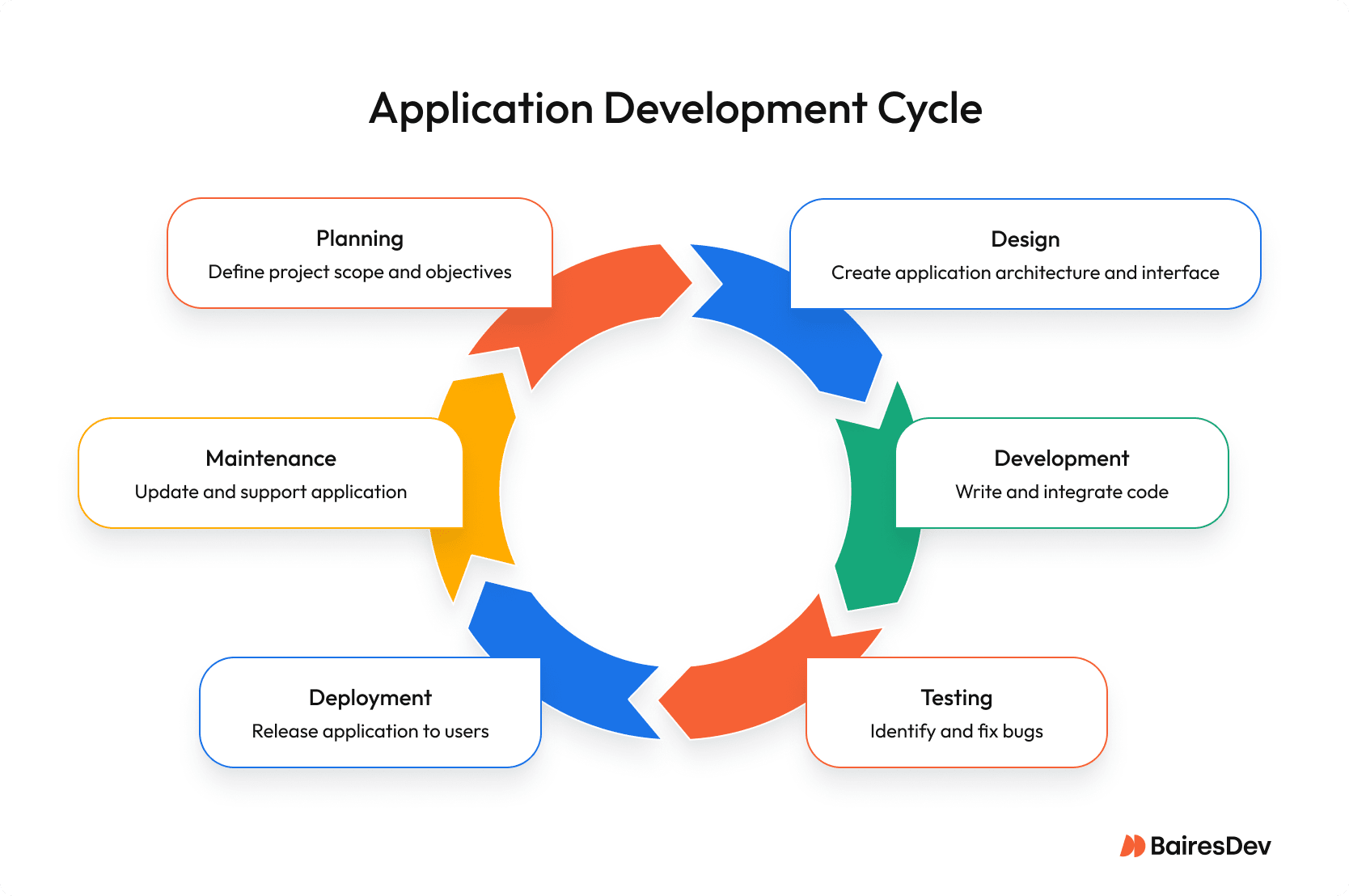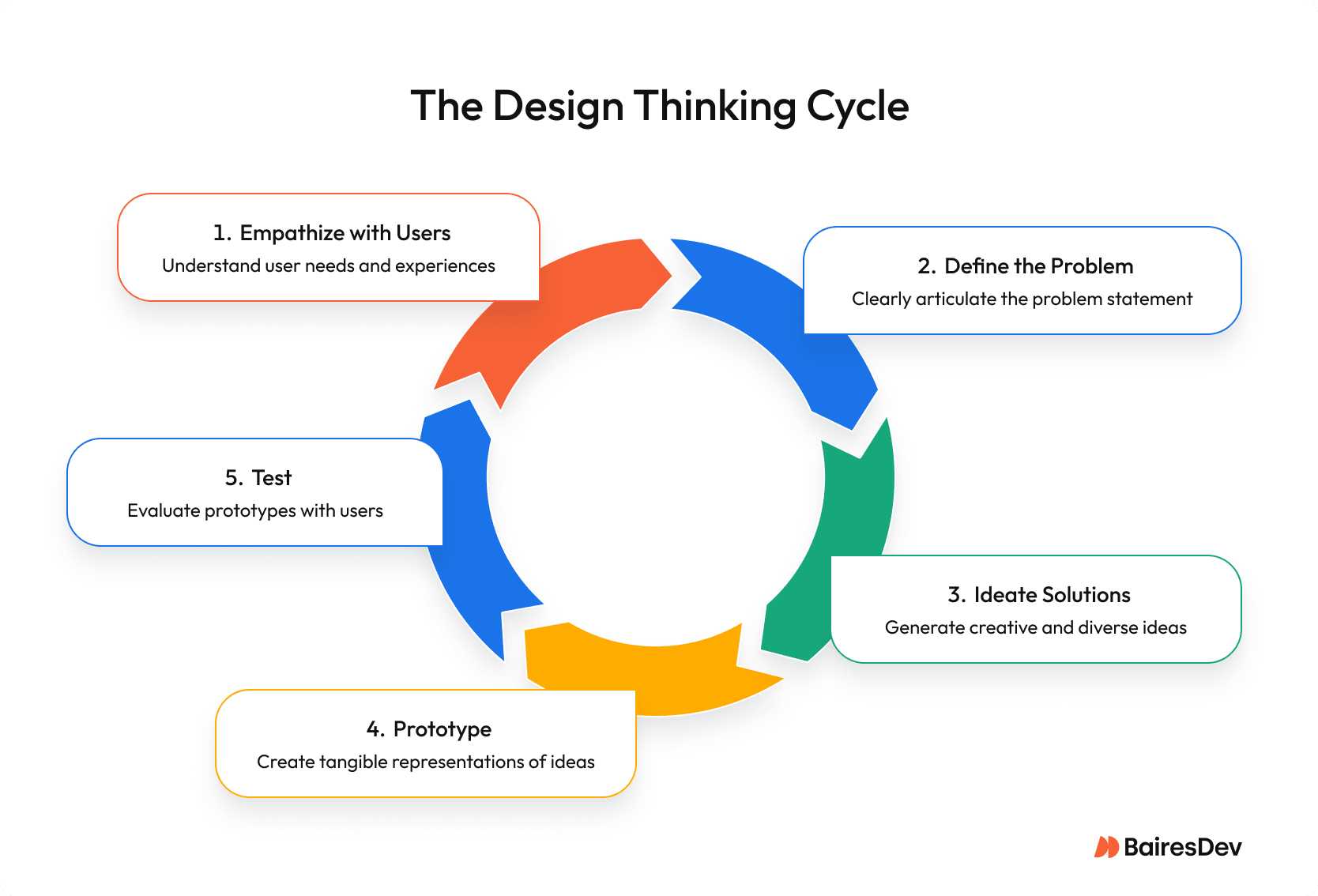Outsourcing only works when it improves the software development lifecycle end to end: clearer requirements, stable velocity, controlled risk, and predictable run costs. Done right, an external partner integrates into your existing workflow without adding overhead, brings the capacity and expertise to maintain momentum, and commits to measurable outcomes at each stage.
This article shows how outsourcing fits into planning, design, development, testing, and operations. What artifacts you should expect? Which controls keep quality high? How do you to structure engagement models that scale without sacrificing accountability?
Software Development Lifecycle
The Software Development Lifecycle (SDLC) is a structured process used to plan, design, develop, test, and deliver software applications. SDLC formalizes who decides what, when, and how—so requirements, quality, and release risks are controlled across stakeholders including customers, internal teams, and external partners.
An application development lifecycle covers the full journey of building software—from planning to delivery. Having a documented lifecycle improves workflow and mitigates risks. It helps ensure that projects are executed with clear accountability, reducing the application’s time to market and lowering costs. The right SDLC framework also establishes quality gates, defines ownership through RACI models, and creates the foundation for measuring delivery performance.
The process starts with planning, where feasibility is tested. Then design, development, and testing shape the product before release. After deployment, updates and maintenance keep the application secure and relevant.
Outsourcing partners bring the extra capacity and expertise to keep that cycle moving without delays, especially when internal teams are already stretched thin. They integrate into existing ceremonies and tooling, contribute to backlogs, and commit to outcomes defined by service levels and delivery cadence.
The Agile Model and Outsourcing – Why Does It Work?
Most organizations today rely on Agile. Its principles—collaboration, adaptability, and speed—fit modern business demands and make it well-suited for outsourced delivery.
Agile provides the flexibility to adjust scope, fix issues early, and deliver incrementally through working software each iteration. Outsourcing partners integrate directly into your sprint ceremonies, contribute to backlog refinement, participate in standups and retrospectives, and commit to velocity targets.
Whether using Scrum, Kanban, or other frameworks, the key is clear ownership, shared tooling, and outcomes tied to sprint goals rather than just hours worked.
At BairesDev, we apply Agile principles across hundreds of active engagements simultaneously, operating as distributed teams integrated into client workflows. Our scale demands disciplined communication, standardized tooling, and outcome-based accountability to ensure transparency and deliver measurable results.
The Cycle
Let’s look at how software outsourcing works over the six stages of the application development process, and what to expect from your engineering partner at each phase:

Planning: Feasibility and Risk Assessment
The planning phase involves documenting the specifics of the project, including how the application should function, its features, and intended development.
Your partner should run a short feasibility spike with clear exit criteria, technical risks identified, and a costed delivery plan. They’ll also include risk mitigation, identifying any potential issues, and ensuring that processes are put in place to reduce their impact.
Discovery and Analysis: Requirements and Project Scope
The discovery phase sets the foundation for the entire project. During this phase, the development team collects requirements from stakeholders to define the project scope, goals, and deliverables.
By identifying potential risks and challenges early, the discovery phase prevents miscommunications, saves time, and provides a clear roadmap for the team. The process then moves into the analysis stage, which focuses on the target audience, system requirements, and functionality of the application.
At this stage, a Software Requirement Specification (SRS) is finalized, outlining the full requirements and key SDLC phases. A software outsourcing team supports this work by breaking tasks into workflows, creating project timescales, and documenting milestones. Understanding project size is vital, as it determines the right SDLC model for effective management.
With a distributed team, companies gain access to a broad pool of skilled developers and structured collaboration through PM tools like Asana and Jira, ensuring project milestones are met.
Design: Architecture and System Blueprint
Based on the requirements set out in the SRS, the design phase defines how the application will be built. This includes system architecture, data models, API contracts, integration points, and security controls. The goal is to create a technical blueprint that guides development and ensures all components work together reliably.
Design decisions made here have long-term implications. Choosing between monolithic or microservices architecture, defining database schemas, establishing authentication and authorization patterns, and planning for scalability all happen at this stage. Architecture Decision Records (ADRs) document these choices and the trade-offs considered.
For distributed teams, design workshops and iterative prototyping help align stakeholders before implementation begins. A strong design phase also includes threat modeling to identify security vulnerabilities early and defining deployment topology to ensure the application can scale in production environments.
At BairesDev, we approach design with a focus on building architectures that support long-term maintainability and performance. Our teams document decisions clearly, create reference architectures that development teams can follow, and validate designs through prototypes before committing to full implementation.

Development: Implementation and Code Production
The implementation phase of application development is typically the longest part of the lifecycle. This is where actual coding takes place and the team transforms design specifications into functional applications. All the application’s features are implemented during the development phase.
Modern development practices include continuous integration (CI), where code is committed frequently and tested automatically. Developers write unit tests alongside their code to catch bugs early, conduct code reviews to maintain quality standards, and use version control systems to track changes and enable collaboration at every stage of the development cycle. Feature flags allow teams to deploy code without immediately exposing new functionality to users, reducing deployment risk.
When using an Agile framework for project management, development happens in sprints with regular ceremonies. Daily standups keep the team synchronized, sprint planning sessions define what will be built, and sprint reviews demonstrate working software to stakeholders. Development and operations teams provide updates on progress, share feedback, and discuss any issues that arise.
At BairesDev, the solid architectures created in the design phase guide our complex projects toward reliable, predictable outcomes during implementation. Our distributed teams integrate into client workflows, participate in all Agile ceremonies, and maintain velocity through standardized practices and clear documentation.
Testing: Quality Assurance and Validation
The testing phase validates that the application meets requirements and performs reliably under real-world conditions. Testing is carried out against the SRS to ensure all specifications from the analysis phase have been met. This phase identifies and tracks defects so fixes can be made before production release.
A comprehensive testing strategy includes system testing to verify end-to-end functionality, performance and load testing to confirm the application scales under expected traffic, security testing using static (SAST) and dynamic (DAST) analysis tools to identify vulnerabilities, and accessibility testing to ensure compliance with standards. Integration testing validates that all components and third-party services work together correctly.
User acceptance testing (UAT) involves stakeholders validating the application against business requirements in a pre-production environment. This is where real users confirm the software solves their problems before it goes live.
Deployment and Maintenance: Release and Ongoing Support
Once the application passes testing and UAT, it moves to production deployment. Modern deployment strategies use CI/CD pipelines with automated health checks, staged rollouts (canary or blue-green deployments), and rollback procedures to minimize risk. Change management processes ensure releases are planned, reviewed, and documented.
Beta testing may occur in a controlled pre-production ring to gather real-world feedback before full release. Production deployment follows change approval with monitoring in place to catch issues immediately.
Maintenance begins as soon as the application goes live. This includes continuous monitoring for performance and security issues, applying patches and dependency updates, capacity tuning as usage grows, and addressing bugs reported by users. Incident response procedures and post-incident reviews help teams learn and improve system reliability over time.
Next Steps
Outsourcing works across every stage of the software development process when structured properly. Every successful application project starts with clear project requirements, a documented SRS, and the right engagement model for your needs. Whether you’re using an iterative model like Agile or need focused capacity for specific phases, the key is finding software developers who integrate into your workflow, understand your technical standards, and commit to measurable outcomes.
The cost of poor execution is measurable: missed deadlines, quality issues, and technical debt that compounds over time. Successful outsourcing depends on treating delivery as a partnership, with shared accountability, transparent communication, and controls that keep both velocity and quality high.
Ready to accelerate your roadmap? Contact us to discuss how nearshore software development can reduce risk and keep your development lifecycle on track.






